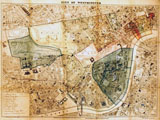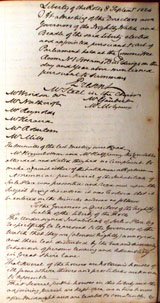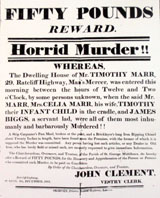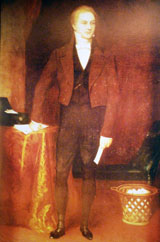Before the Police: Parish Police
Apart from the experiments in Bow street and with the Police Offices, most policing in London remained the responsibility of local government. The parish was the principal instrument of local government in eighteenth-century London.
Each parish had a number of constables. Traditionally these were recruited from householders, often by house rotation with men being replaced annually, in turn by their neighbours. Such constables maintained their usual job as butchers, bakers, candlestick-makers, or whatever, and took fees for their police duties. As the eighteenth century progressed, however, there were more and more men serving as semi-professional constables. A few did this out of a determination to enforce particular laws or reforms – to suppress vice, for example, or gambling. Rather more agreed to serve in place of the householder selected, for a payment, and then maximised the fees that they could claim as a constable.

In addition to the constables there were parish watchmen. In 1285 the Statute of Winchester required that all householders should take their turn during the summer months to patrol their neighbourhood. Householders were increasingly reluctant to take on this duty and, increasingly, watchmen began to be recruited and paid for their duties. Legislation proposed by two Westminster parishes (St James, the area in the vicinity of numbers 5 and 6 on the City of Westminster map, and St George, by the number 13 on the map) in 1735 allowed a local rate to be levied to pay for the appointment of night watchmen. Over the next fifty years 40 parishes followed in their footsteps.
The map shows the patchwork layout of the Westminster parishes c.1774. What might this map suggest about the structure of policing in eighteenth-century London?

The fragmentary nature of the parishes suggests a lack of co-ordination in policing across the metropolis. In many respects this was the case, but look now at the minutes of the meeting of Directors and Governors of the Liberty of Rolls (part of the City of Westminster) for 8 September 1824 discussing the problems of vagabonds and night walkers. [A transcript is available.] This document suggests that parishes did not always act in isolation.
By 1822 there were approximately 3,860 parish officers who played a role in policing within the bounds of the metropolis. As noted earlier, they have been much criticised by police reformers and the traditional police historians.
But other evidence suggests a rather different picture.
What does the following suggest about complaints? The example below appears in the St. Martin Complaint Book for September 1825.

This suggests that complaints were taken seriously and that punishments were meted out for misconduct.
As the following extract from the meeting of the Trustees of St Mary le Strand shows, inefficient or incompetent watchmen were dismissed.

What do the following documents suggest about the practices of the watchmen?
- Rolls Table of Beats
- St James Attendance Book
- St James Charge Book
- a handbill of 1818 for the Hamlet of Ratcliffe
Although a full explanation of the Table of Beats is uncertain, it is clear that officers' beats are recorded on a daily basis. The attendance book, on the other hand, shows the watch in St James to have well-defined beats similar to those that were subsequently patrolled by Metropolitan Police officers. In this book a double page spread covers a calendar month: constables listed down the left hand side page with the dates across the top of the page and their attendance recorded in the table. The beat that each constable has to cover is listed alongside his name.
The Charge Book shows the role of watchmen to have been largely similar to that of the new police: dealing with drunks, prostitutes, vagrants and other disorderly people, checking that premises were secure, and stopping suspicious characters. As the handbill from Ratcliffe notes, they also had a wider role in looking out for other problems for the community – in this case, fire.
While it is not clear from these documents it is also significant that beadles also patrolled the streets at night to keep an eye on watchmen, writing reports for the constables. When a watchman brought an offender to the watchbox, he would be delivered to a justice of the peace by the constable. By 1829, most of the men recruited as watchmen by the London parishes were under 40 years of age and selected with care often from former soldiers.
 There were problems. Vouchers were awarded to constables who apprehended a burglar, absolving the holder from parish duties for life. This could lead to abuse and, by 1816, these tickets were changing hands for £25. Watchmen were also accused of fraternizing with prostitutes and being corrupt. And terrible crimes could lead to the whole system being condemned for inefficiency. On the morning of Sunday 8 December 1811, for example, Timothy and Celia Marr, their 14 week old baby, and their shop boy James Gowen, were beaten to death in their draper’s shop at 29 Ratcliffe Highway. The murder caused such disgust that the vestry offered a £50 reward to anyone brining the killer to justice.
There were problems. Vouchers were awarded to constables who apprehended a burglar, absolving the holder from parish duties for life. This could lead to abuse and, by 1816, these tickets were changing hands for £25. Watchmen were also accused of fraternizing with prostitutes and being corrupt. And terrible crimes could lead to the whole system being condemned for inefficiency. On the morning of Sunday 8 December 1811, for example, Timothy and Celia Marr, their 14 week old baby, and their shop boy James Gowen, were beaten to death in their draper’s shop at 29 Ratcliffe Highway. The murder caused such disgust that the vestry offered a £50 reward to anyone brining the killer to justice.
12 days later – and only a few hundred yards away – at the King’s Arms, New Gravel Street, three more people were murdered. In both cases, nothing was stolen from the properties. These killings were seen as a damning indictment of police incompetence. The night watch of Shadwell – 40 men – was sacked and replaced by armed patrols.
The investigations into policing by parliamentary select committees at the beginning of the nineteenth century questioned many of those involved with different watches. Both James Bartlett and Thomas Goodwin gave evidence.
Overall the watches were reasonably efficient, and they appear to have been becoming more so. Thus the reforms of Peel were not as revolutionary as many contemporaries and some historians alleged. As we shall see the creation of the new police rationalized and extended the practices of the watch, but the basic principles of policing were not altered.
 Sir Robert Peel
Sir Robert Peel